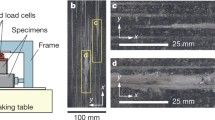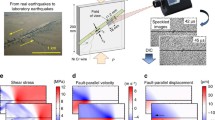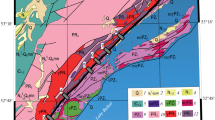Abstract
Despite considerable effort over the past several decades, the mechanics of earthquake rupture remains largely unknown. Moderate- to large-magnitude earthquakes nucleate at 7–15 km depth and most information is retrieved from seismology, but information related to the physico-chemical processes active during rupture propagation is below the resolution of this method. An alternative approach includes the investigation of exhumed faults, such as those described here from the Adamello Massif (Italian Alps), and the use of rock deformation apparatus capable of reproducing earthquake deformation conditions in the laboratory. The analysis of field and microstructural/mineralogical/geochemical data retrieved from the large glacier-polished exposures of the Adamello (Gole Larghe Fault) provides information on earthquake source parameters, including the coseismic slip, the rupture directivity and velocity, the dynamic friction and earthquake energy budgets. Some of this information (e.g., the evolution of the friction coefficient with slip) can be tested in the laboratory with the recently installed Slow to HIgh Velocity Apparatus (SHIVA). SHIVA uses two brushless engines (max power 280 kW) and an air actuator in a rotary shear configuration (nominally infinite displacement) to slide solid or hollow rock cylinders (40/50 mm int/ext diameter) at: (1) slip rates ranging from 10 μm s−1 up to 9 m s−1; (2) accelerations up to 80 m s−2; and (3) normal stresses up to 50 MPa. In comparison to existing high-speed friction machines, this apparatus extends the range of sliding velocities, normal stresses and sample size. In particular, SHIVA has been specifically designed to reproduce slip velocities and accelerations that occur during earthquakes. The characterization of rock frictional behavior under these conditions, plus the comparison with natural fault products, is expected to provide important insights into the mechanics of earthquakes.






Similar content being viewed by others
References
Andrews DJ (2005) Rupture dynamics with energy loss outside the slip zone. J Geophys Res 110. doi:101029/2004JB003191
Beeler NM (2006) Inferring earthquake source properties from laboratory observations and the scope of lab contributions to source physics. In: Abercrombie R, McGarr A, Di Toro G, Kanamori H (eds) Radiated energy and the physics of faulting. AGU Geophysical Monograph Series 170, Washington, DC, pp 99–119
Beeler NM, Tullis TE (1996) Self-healing slip pulse in dynamic rupture models due to velocity dependent strength. Bull Seismol Soc Am 86:1130–1148
Beeler NM, Tullis TE, Goldsby DL (2008) Constitutive relationships and physical basis of fault strength due to flash heating. J Geophys Res 113:B01401. doi:10.1029/2007JB004988
Bizzarri A, Cocco M (2006) A thermal pressurization model for the spontaneous dynamic rupture propagation on a three-dimensional fault. 1. Methodological approach. J Geophys Res 111:B05303. doi:10.1029/2005JB003862
Brace WF, Byerlee JD (1966) Stick slip as a mechanism for earthquakes. Science 168:990–992
Brantut N, Schubnel A, Rouzaud JN, Brunet F, Shimamoto T (2008) High-velocity frictional properties of a clay bearing fault gouge and implications for earthquake mechanics. J Geophys Res 113:B10401. doi:10.1029/2007JB005551
Brodsky EE, Kanamori H (2001) Elastohydrodynamic lubrication of faults. J Geophys Res 106:16,357–16374
Byerlee JD (1978) Friction of rocks. Pure Appl Geophys 116:615–626
Chester JS, Chester FM, Kronenberg AK (2005) Fracture surface energy of the Punchbowl Fault, San Andreas System. Nature 437:133–136
Cocco M, Spudich P, Tinti E (2006) On the mechanical work absorbed on faults during earthquake ruptures. In: Abercrombie RE, McGarr A, Kanamori H, Di Toro G (eds) Radiated energy and the physics of earthquake faulting. AGU Monograph Series 170, Washington, DC, pp 237–254
Cowan DS (1999) Do faults preserve a record of seismic faulting? A field geologist’s opinion. J Struct Geol 21:995–1001
Del Gaudio P, Di Toro G, Han R, Hirose T, Nielsen S, Shimamoto T, Cavallo A (2009) Frictional melting of peridotite and seismic slip. J Geophys Res 114. doi:1029/2008JB005990
Dieterich JH (1978) Time-dependent friction and the mechanics of stick-slip. Pure Appl Geophys 116:790–806
Dieterich JH (1979) Modeling of rock friction. 1. Experimental results and constitutive equations. J Geophys Res 84:2161–2168
Di Toro G, Pennacchioni G (2004) Superheated friction-induced melts in zoned pseudotachylytes within the Adamello tonalites (Italian Southern Alps). J Struct Geol 26:1783–1801
Di Toro G, Pennacchioni G (2005) Fault plane processes and mesoscopic structure of a strong-type seismogenic fault in tonalites (Adamello batholith, Southern Alps). Tectonophysics 402:54–79
Di Toro G, Goldsby DL, Tullis TE (2004) Friction falls towards zero in quartz rock as slip velocity approaches seismic rates. Nature 427:436–439
Di Toro G, Pennacchioni G, Teza G (2005a) Can pseudotachylytes be used to infer earthquake source parameters? An example of limitations in the study of exhumed faults. Tectonophysics 402:3–20
Di Toro G, Nielsen S, Pennacchioni G (2005b) Earthquake rupture dynamics frozen in exhumed ancient faults. Nature 436:1009–1012
Di Toro G, Hirose T, Nielsen S, Pennacchioni G, Shimamoto T (2006) Natural and experimental evidence of melt lubrication of faults during earthquakes. Science 311:647–649
Di Toro G, Nielsen S, Pennacchioni G (2009) Pseudotachylytes and earthquake source mechanics. In: Fukuyama E (ed) Fault-zone properties and earthquake rupture dynamics. International Geophysics Series. Elsevier, Amsterdam, pp 87–133
Fukuyama E, Mizoguchi K (2010) Constitutive parameters for earthquake rupture dynamics based on high-velocity friction tests with variable slip rate. Int J Fract 163:15–22
Goldsby DL, Tullis TE (2002) Low frictional strength of quartz rocks at subseismic slip rates. Geophys Res Lett 29. doi:10.1029/2002GL01240
Guatteri M, Spudich P (1998) Coseismic temporal changes of slip direction; the effect of absolute stress on dynamic rupture. Bull Seismol Soc Am 88:777–789
Guatteri M, Spudich P (2000) What can strong-motion data tell us about slip-weakening fault-friction laws? Bull Seismol Soc Am 90:98–116
Han R, Hirose T, Shimamoto T (2010) Strong velocity weakening and powder lubrication of simulated carbonate faults at seismic slip rates. J Geophys Res 115:B03412. doi:10.1029/2008JB006136
Han R, Shimamoto T, Hirose T, Ree J-H, Ando J (2007) Ultralow friction of carbonate faults caused by thermal decomposition. Science 316:878–881
Hayashi N, Tsutsumi A (2010) Deformation textures and mechanical behavior of a hydrated amorphous silica formed along an experimentally produced fault in chert. Geophys Res Lett 37:L12305. doi:10.1029/2010GL042943
Heaton TH (1990) Evidence for and implications of self healing pulses of slip in earthquake rupture. Phys Earth Planet Int 64:1–20
Hirose T, Shimamoto T (2005) Growth of molten zone as a mechanism of slip weakening of simulated faults in gabbro during frictional melting. J Geophys Res 110:B05202. doi:10.1029/2004JB003207
Jeffreys H (1942) On the mechanics of faulting. Geol Mag 79:291–295
Kame N, Rice JR, Dmowska R (2003) Effects of pre-stress state and rupture velocity on dynamic fault branching. J Geophys Res 108:B2205. doi:10.1029/2002JB002189
Kanamori H, Brodsky E (2004) The physics of earthquakes. Rep Prog Phys 67:1429–1496
Kitajima H, Chester JS, Chester FM, Shimamoto T (2010) High-speed friction of disaggregated ultracataclasite in rotary shear: characterization of frictional heating, mechanical behavior, and microstructure evolution. J Geophys Res. doi:10.1029/2009JB007038
Kostrov B, Das S (1988) Principles of earthquake source mechanics. Cambridge University Press, London
Lachenbruch AH (1980) Frictional heating, fluid pressure, and the resistance to fault motion. J Geophys Res 85:6249–6272
Lee WH, Kanamori H, Jennings PC, Kisslinger C (2002) Earthquake & engineering seismology, vol 1 and 2. Academic Press, Amsterdam
Lockner DA, Beeler NM (2002) Rock failure and earthquakes. In: Lee WH, Kanamori H, Jennings PC, Kisslinger C (eds) Earthquake & engineering seismology. Academic Press, Amsterdam, pp 505–537
Marone C (1998) Laboratory-derived friction laws and their application to seismic faulting. Annu Rev Earth Planet Sci 26:643–696
Mayeda K, Walter WR (1996) Moment, energy, stress drop, and source spectra of western United States earthquakes from regional coda envelopes. J Geophys Res 101:11195–11208
McKenzie D, Brune JN (1972) Melting on fault planes during large earthquakes. Geophys J R Astron Soc 29:65–78
Melosh J (1996) Dynamic weakening of faults by acoustic fluidization. Nature 397:601–606
Nielsen S, Di Toro G, Hirose T, Shimamoto T (2008) Frictional melt and seismic slip. J Geophys Res 113:B01308. doi:10.1029/2007JB0051222008
Pennacchioni G, Di Toro G, Brack P, Menegon L, Villa IM (2006) Brittle-ductile-brittle deformation during cooling of tonalite (Adamello, Southern Italian Alps). Tectonophysics 427:171–197
Pittarello L, Di Toro G, Bizzarri A, Pennacchioni G, Hadizadeh J, Cocco M (2008) Energy partitioning during seismic slip in pseudotachylyte-bearing faults (Gole Larghe Fault, Adamello, Italy). Earth Planet Sci Lett 269:131–139
Poliakov ANB, Dmowska R, Rice JR (2002) Dynamic shear rupture interactions with fault bends and off-axis secondary faulting. J Geophys Res 107:B2295. doi:10.1029/2001JB000572
Reches Z, Lockner DA, Chang JC, Totten MW (2009) Earthquake-like slip events on an analog laboratory fault. 2009 Southern California Earthquake Center Annual Meeting Proceedings and Abstracts, vol 19, p 320
Rice JR (2006) Heating and weakening of faults during earthquake slip. J Geophys Res 111:B05311. doi:10.1029/2005JB004006
Ruina A (1983) Slip instability and state variable friction laws. J Geophys Res 88:10359–10370
Schmid SM, Aebli HR, Heller F, Zingg A (1989) The role of the Periadratic Line in the tectonic evolution of the Alps. In: Coward MP, Dietrich D, Park RG (eds) Alpine tectonics. Geological Society Special Publication 45, London, pp 153–171
Scholz CH (1998) Earthquakes and friction laws. Nature 391:37–42
Scholz CH (2002) The mechanics of earthquakes and faulting. Cambridge University Press, Cambridge
Shand SJ (1916) The pseudotachylyte of Parijs (Orange Free State) and its relation to “trap-shotten gneiss” and “flinty crush rock”. Q J Geol Soc Lond 72:198–221
Shimamoto T, Tsutsumi A (1994) A new rotary-shear high-speed frictional testing machine: its basic design and scope of research. J Tecton Res Group Jpn 39:65–78 (in Japanese with English abstract)
Sibson RH (1973) Interactions between temperature and pore fluid pressure during earthquake faulting—a mechanism for partial or total stress relief. Nature 243:66–68
Sibson RH (1975) Generation of pseudotachylyte by ancient seismic faulting. Geophys J R Astron Soc 43:775–794
Sibson RH, Toy V (2006) The habitat of fault-generated pseudotachylyte: presence vs. absence of friction melt. In: Abercrombie R, McGarr A, Di Toro G, Kanamori H (eds) Radiated energy and the physics of faulting. AGU Geophysical Monograph Series 170, Washington, DC, pp 153–166
Sone H, Shimamoto T (2009) Frictional resistance of faults during accelerating and decelerating earthquake slip. Nat Geosci 2:705–708
Spray JG (1987) Artificial generation of pseudotachylyte using friction welding apparatus: simulation of melting on a fault plane. J Struct Geol 9:49–60
Spray JG (1992) A physical basis for the frictional melting of some rock forming minerals. Tectonophysics 204:205–221
Spray JG (1995) Pseudotachylyte controversy: fact or friction? Geology 23:1119–1122
Spray JG (2005) Evidence for melt lubrication during large earthquakes. Geophys Res Lett 32:L07301. doi:10.1029/2004GL022293
Swanson MT (1992) Fault structure, wear mechanisms and rupture processes in pseudotachylyte generation. Tectonophysics 204:223–242
Tisato N, Di Toro G, De Rossi N, Quaresimin M (2009) Experimental investigation of flash weakening in limestones. South California Earthquake Center Annual Meeting, Palm Springs, USA
Tripoli A (2008) High velocity rock friction apparatus, Progetto Preliminare. Project Report TA-2007-3-Rev 1 (in Italian)
Tsutsumi A, Shimamoto T (1997) High velocity frictional properties of gabbro. Geophys Res Lett 24:699–702
Tullis TE (1988) Rock friction constitutive behavior from laboratory experiments and its implications for an earthquake prediction field monitoring program. Pure Appl Geophys 126:556–588
Tullis TE (2008) Rheology of fault rocks and their surrounding. In: Handy MR, Hirth G, Hovious N (eds) Tectonic faults. The MIT press, Cambridge, pp 183–204
Venturelli G, Thorpe RS, Dal Piaz GV, Potts PJ (1984) Petrogenesis of calc-alkaline, shoshonitic and associated ultrapotassic Oligocene volcanic rocks from the northwestern Alps, Italy. Contr Miner Petrol 86:209–220
Wibberley CAJ, Graham Y, Di Toro G (2008) Recent advances in the understanding of fault zone internal structure: a review. In: Wibberley CAJ, Kurz W, Imber J, Holdsworth RE, Collettini C (eds) The internal structure of fault zones—implications for mechanical and fluid flow properties. Special Volume of the Geological Society of London 299, pp 5–33
Yuan F, Prakash V (2008a) Use a modified torsional Kolsky bar to study frictional resistance in rock-analog materials. Int J Solids Struct 45:4247–4263
Yuan F, Prakash V (2008b) Slip weakening in rocks and analog materials at co-seismic slip rates. J Mech Phys Sol 56:542–560
Zheng G, Rice JR (1998) Conditions under which velocity-weakening friction allows a self-healing versus a crack-like Mode of rupture. Bull Seismol Soc Am 88:1466–1483
Acknowledgments
We thank Francesco Paolo Sassi and Giorgio Vittorio Dal Piaz for encouraging us in writing this paper. G.D.T., A.N. and S.S wrote the manuscript. A.T., G.S., R.A., G.D.T., S.N. and P.S. worked on the design of SHIVA. F.D.F., A.N., S.N., G.R., G.D.S. and E.S. implemented the control and acquisition system of SHIVA. S.M. and P.S. managed the installation of SHIVA at INGV. We thank Toshihiko Shimamoto for discussions about an initial design of SHIVA. SHIVA was funded by the European Research Council Starting Grant 205175 USEMS (Principal Investigator G.D.T.) and by the Progetto FIRB “Development of innovative technologies for the environmental protection from natural events” (Principal Investigator P.S.). We acknowledge Enzo Boschi, Massimo Cocco and Antonio Piersanti for supporting the installation of SHIVA at INGV.
Author information
Authors and Affiliations
Corresponding author
Rights and permissions
About this article
Cite this article
Di Toro, G., Niemeijer, A., Tripoli, A. et al. From field geology to earthquake simulation: a new state-of-the-art tool to investigate rock friction during the seismic cycle (SHIVA). Rend. Fis. Acc. Lincei 21 (Suppl 1), 95–114 (2010). https://doi.org/10.1007/s12210-010-0097-x
Received:
Accepted:
Published:
Issue Date:
DOI: https://doi.org/10.1007/s12210-010-0097-x




